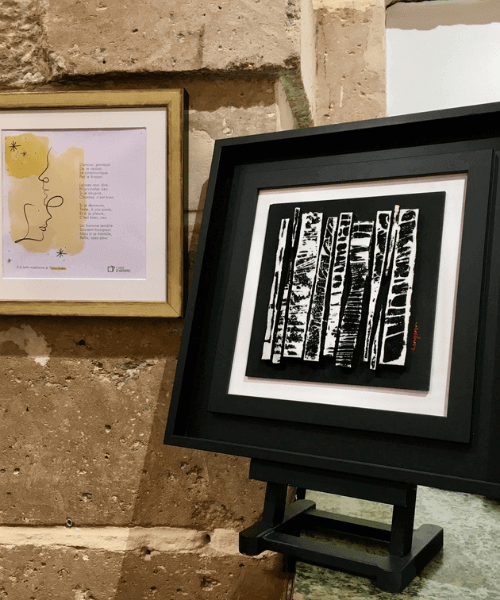Understanding the valuation of an artwork
Works of art sometimes fetch millions of dollars at auctions.
However, these astronomical sums are reserved for the works of the most famous artists.
To help you choose an artwork, here is an explanation of the art market, artist ratings and the essential criteria to take into account in order to estimate the price of a creation.
Summary
- The price of a work of art set according to the market
- The price criteria according to the work
- Guarantees of the authenticity of a work
The price of an artwork set according to the market
While some artists' works reach very large sums, others, of the same format or identical technique, are more affordable.
The price is fixed according to the quotation of the artist which is dependent on the art market.
What is the art market?
The art market is the trade in works between artists, their intermediaries and buyers.
Auction prices are recorded, in order to note the financial development of an artist's work.
Like any business, prices fluctuate due to supply and demand.
The value of a painting, a sculpture or any other work depends, among other things, on the notoriety of its author.
The rating of an artist
The rating of an artist, that is to say the financial value of his works, is determined according to the results of the auctions of his creations.
For example, to know the price of a painting by Pablo Picasso, you must compare with the painter's last sales of similar works (identical formats and techniques).
An average is established. In order to find out about artists' ratings, there are databases available online.
Auction house sites also publish auction results.
Finally, the experts provide information on the financial values of the works.
A fluctuating art market
The price changes depending on the economy, but also on the artist's career, his exhibitions and his popularity.
The support of reputable art collectors promotes the notoriety of the creator.
Its inclusion in the collections of large galleries or museums strengthens its rating.
Moreover, a drawing or a silkscreen does not sell for the same price as a painting or a sculpture. An expert in the art market knows all the tricks and knows precisely the price of an artist.


The paintings of the most popular artists
In 2020, in the most famous art auction houses in the world such as New York or London, paintings reached impressive prices, despite the crisis.
Some auctions have gone up to more than 68 million euros, such as that of Francis Bacon's painting Inspired by the Oresteia of Aeschylus.
Among the most popular artists are masters of modern art such as Pablo Picasso, Paul Gauguin and Vincent Van Gogh. In contemporary art, the works of artists Jeff Koons and Damien Hirst reach impressive sums.
The price criteria according to the work
If an artist's works have not yet been auctioned, and therefore not yet listed, certain criteria make it possible to set reasonable prices for any buyer. Each artist, gallery owner or art dealer remains free to set prices.
The format of the creation
The price of a creation is set according to the artist's price, but also in relation to its format.
A small-sized canvas will be cheaper than a large-format work, which is legitimate. For emerging artists, the price is often set according to the size of the paintings.
Thus, affordable prices make it possible to help the work of young designers and, for collectors, to bet on artistic talent.
The technique used
Depending on the medium used, a work does not sell at the same price.
A painting on canvas is less expensive than a monumental sculpture, a drawing is more affordable than an oil painting.
The material used is taken into account.
For example, a painting covered with gold leaf, a quality basic material, will be valued at a higher price.
Of course, the notoriety of the artist must always be taken into account.
The digital artwork Everydays: The First 5000 days by Mike Winkelmann, aka Beeple, fetched $ 69 million, or € 58 million, at a Christie's auction. Here, on the contrary, it is its specificity and not its technique that has made it possible to achieve such a sum.
Visual quality
It is always difficult to mention any visual quality for a work.
Remember the paintings of wild beasts or cubists which caused a scandal in their time, and are now the subject of exhibitions all over the world. Experts in the art market know, however, how to recognize a quality creation.
The composition, the mastery of the forms and the subject are essential criteria.
Conservation of the work
The good condition of the creation matters a lot in the amount of its price.
A yellowed drawing, a torn canvas or a broken sculpture thus loses its value.
This is why it is important to protect the works from the risk of humidity, heat or too much light during their exhibition.
Guarantees of the authenticity of a work
The legitimacy of a work of art is guaranteed by its certificate of authenticity issued by art dealers, even for the creations of emerging artists.
The signature also makes it possible to verify with certainty the identity of the author, which increases the price.
Contemporary articles:
On the subject:
How to choose an artwork?
find out more :
- How to choose a contemporary artwork?
- How to choose a modern artwork?
- The signature of an artwork
- The certificate of authenticity of an artwork



